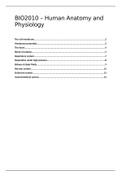BIO2010 – Human Anatomy and
Physiology
The cell membrane.............................................................................................................2
Membrane potentials.........................................................................................................3
The heart............................................................................................................................4
Blood circulation................................................................................................................5
Respiratory system.............................................................................................................7
Respiration under high pressure.........................................................................................8
Kidneys & Body fluids.........................................................................................................9
Nervous system................................................................................................................12
Endocrine system.............................................................................................................13
Gastrointestinal system....................................................................................................14
,The cell membrane
Cell membrane:
Separates intercellular from extracellular environment. Controls what goes in and out of the
cell and is therefore selective permeable.
Bilayer of phospholipids (25%) with a polar head group, a glycerol backbone and fatty acid
chains. The inside is hydrophobic, the outside is hydrophilic.
o Cholesterol (13%): Integrated in the membrane every several molecules. Controls
the fluidity of the membrane, which is important for its function, since it determines
where proteins stick.
Warm temperature cholesterol stiffens the membrane in order to
restrain movement of phospholipids.
Cold temperature cholesterol prevents makes the membrane more fluid,
so the lipids won’t stick together too much.
o Proteins (55%): integral (through the whole membrane, hydrophobic) and
pheripheral (on the membrane surface, hydrophilic).
o Membrane junctions for interaction between cells to form tissues: tight junctions
(molecular movement from cell to cell), desmosomes (holding cells together for
stretching), gap junctions (channels made by 12 connexin molecules, 6 from every
cell)
o Carbohydrates (3%) on the outside of the cell, attract water, forms a gel for
protection
o Transport enzymes and pores through both phospholipid layers, receptors and
identification (membrane) molecules on the outside of the membrane.
There are different ways of transportation in/out of the cell:
Passive transport: no energy needed
Diffusion: movement of molecules as a result of their thermal motion, from a higher
concentration gradient to a lower concentration gradient. Eventually reaches equilibrium
with similar concentrations at both sites. The diffusion rate is influenced by concentration
gradient, charge gradient (causes membrane potential), thickness of the membrane,
temperature, molecular mass, surface area, medium resistance and diffusion coëfficient of
the molecule. (oxygen, carbon dioxide, water)
o Simple diffusion: through gated channels that need an electrical/chemical signal
o Facilitated diffusion: carrier protein needed to push the transported molecule
through the membrane. Has a maximum rate because at a certain point, all
transport proteins will be occupied and this will limit the occurrence of diffusion.
Osmosis: diffusion of water to a higher osmotic pressure
Filtration: based on pressure differences
Active transport: needs energy, like pumps/transport enzymes
Primary active transport: energy needed comes directly from ATP
Secondary active transport: energy needed comes from gradient of other molecules
(cotransporters/exchangers) diffusing into the cell. Example: diffusion of sodium used to
transport glucose into the cell.
o Cotransport: when both compounds travel in the same direction
Carrier proteins: transport of ions, glucose, etc.
Endocytosis:
Pinocytosis: when an endocytotic vesicle encloses a small volume of extracellular fluid or
when an extracellular molecule is carried into the cell along with the extracellular fluid.
Phagocytosis: when the membrane folds around the surface of a big particle so that little
extracellular fluid is enclosed (digestion of bacteria).
, Exocytosis
A route for molecules that cannot pass the membrane to leave the cell packaged in vesicles.
Opposite of endocytosis
Epithelial transport
Either through cells or between cells of the endothelial cell layer.
There are different types of cell communication
Cell-cell signaling: when cells have contact/are present in the same tissue/have affinity for
each other
With use of hormones:
o Autocrine: binds to the same cell
o Paracrine: binds to a cell nearby, travels through extracellular environment
o Endocrine: binds to cells further away, travels through circulatory system
o Intracrine: receiver is the same cell
Synaptic signaling: specific paracrine signaling for neurons
Membrane potentials
Some membranes have a membrane potential, a difference of electric charge across a membrane.
This potential is formed by a different charge gradient inside and outside the cell caused by a small
number of ions. In this case diffusion reaches a polar equilibrium. This resting potential is usually -90
mV in nerve cells. After excitation through a certain stimulus/signal (mechanical, chemical or
electrical), a few sodium channels of the membrane open and sodium ions are transported into the
cell and the membrane depolarizes slightly. If the membrane potential exceeds over the threshold of
-65mV, all voltage gated sodium channels open (all or nothing principle) and the membrane
potential depolarizes to a positive one, which causes an action potential of around +35 mV. The
same threshold causes the potassium channels to open, however they take longer to open, so only
when the sodium channels close, voltage gated potassium channels open. This leads to potassium
transport out of the cell, after which the membrane potential repolarizes back to the resting state
after a short hyperpolarization.
The transport of sodium and potassium is provided by:
Na+/K+ pumps (constantly)
Na+/K+ leakage channels (during action potential)
Voltage gated K+ and Na+ channels (during action potential)
3 types of muscles tissue with different action potentials:
Skeletal muscle
o Controlled voluntarily by acetyl choline receptors
o Nerve stimulus causes depolarization (chemical induction)
o Depolarization of around 1 ms (5ms action potential)
o Effect on myosin and actin molecules myosin hinges to actin muscle cell
contracts
Cardiac muscle
o Controlled involuntarily by the syncytium (group of cardiomyocytes which work as a
functional unit to contract at the same time), depolarizes without any external
influence.
o Depolarization when sodium channels open and sodium leaks in
o Plateau when potassium leaks out and calcium leaks in, so a long refractory period
o Repolarization when potassium leaks out and no ions leak in
o Rest state = -90mV, threshold = -70 mV, peak = +20mV
o Action potential of around 200-400 ms
Smooth muscle




